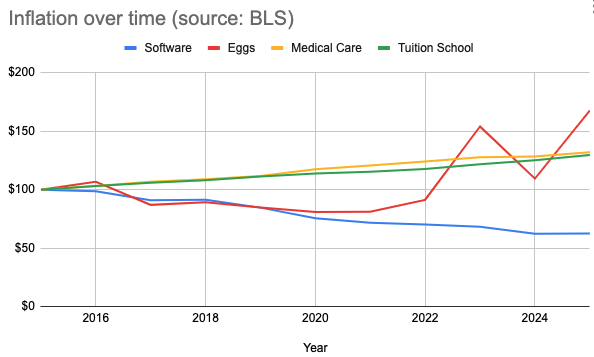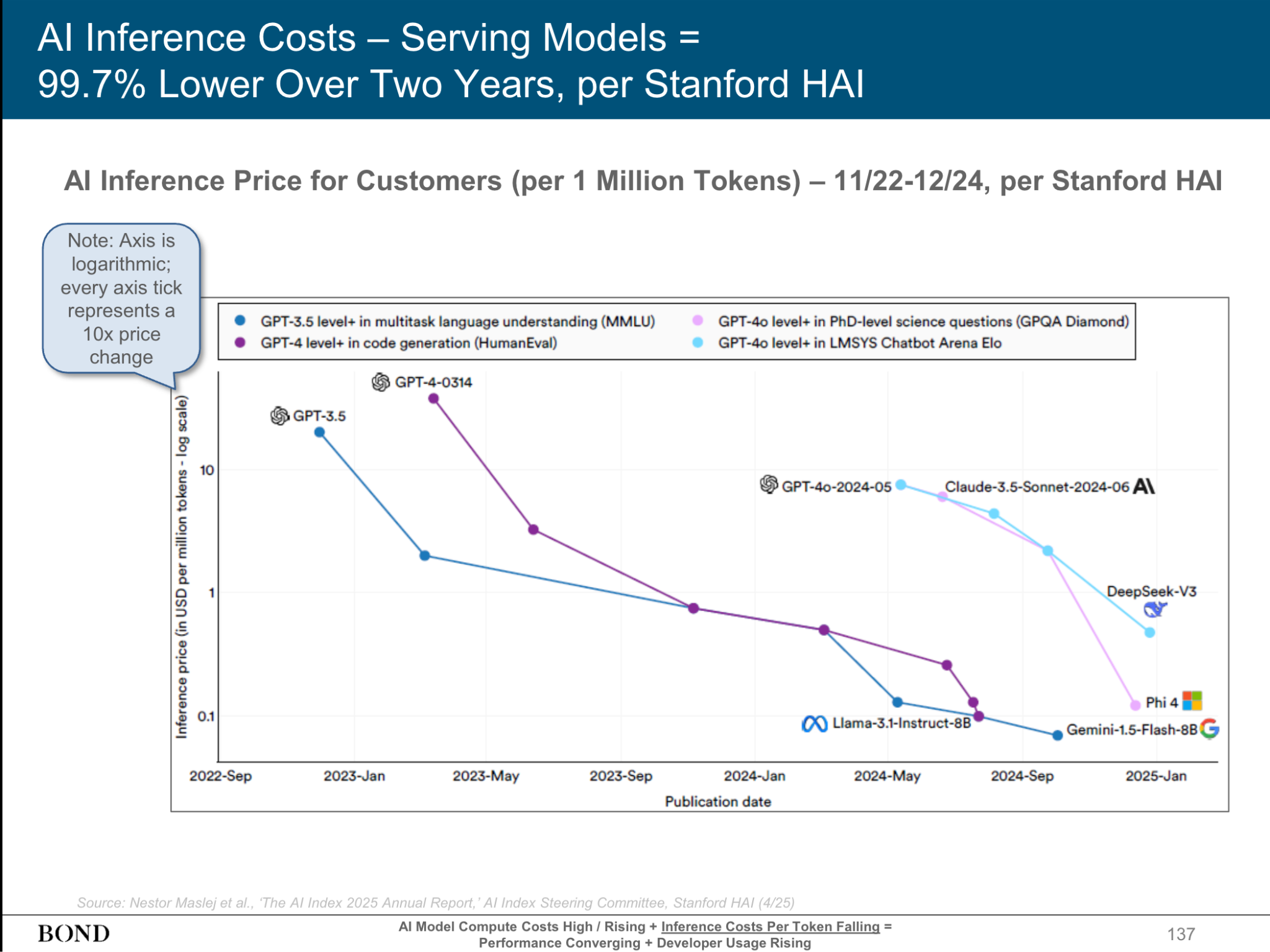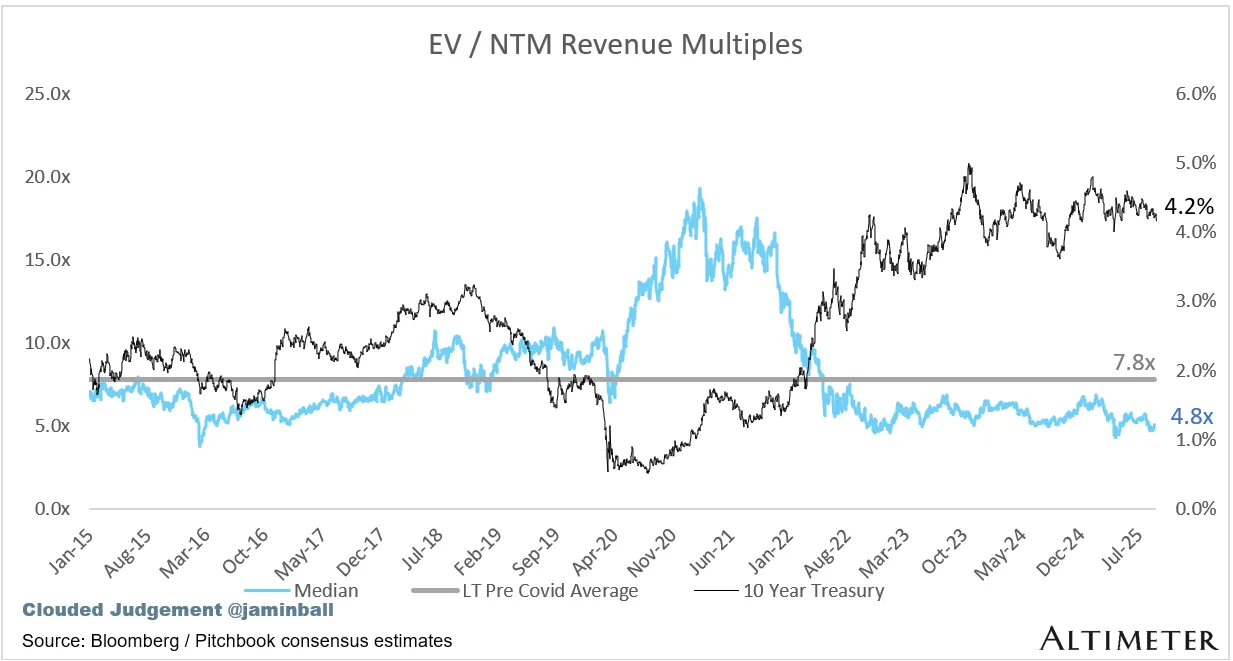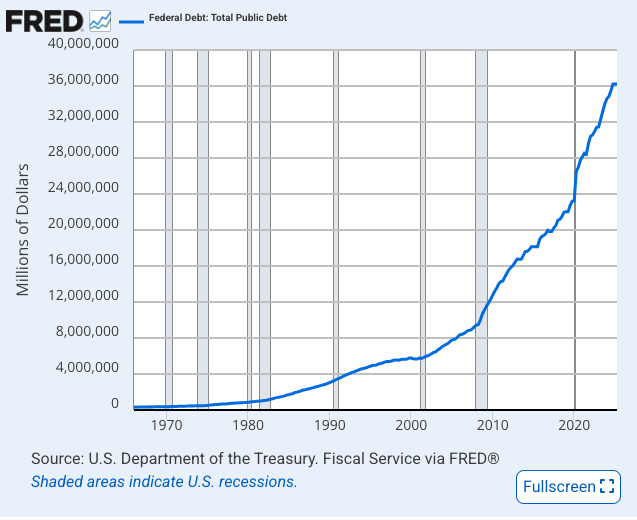
Frameworks, core principles and top case studies for SaaS pricing, learnt and refined over 28+ years of SaaS-monetization experience.
Thank you! Your submission has been received!
Oops! Something went wrong while submitting the form.
Pricing Strategy

.jpg)
We're standing at the edge of a fundamental transformation in the software industry, one that most executives, investors, and even seasoned operators haven't fully grasped yet. While we've all been focused on the AI revolution and its promise of unprecedented productivity gains, we've missed a crucial paradox: the very innovations that are supposed to propel software forward are simultaneously undermining the economic foundations that made the SaaS model so attractive in the first place.
This isn't just another market cycle or temporary adjustment. We're witnessing what can only be described as a regime change, a complete restructuring of how software companies create, deliver, and capture value. The implications are profound, affecting everything from unit economics to go-to-market strategies, from company valuations to the very definition of what constitutes a software company.
Here's a shocking truth that should keep every software executive awake at night: while the cost of everything around us seems to be spiraling upward, from your morning coffee to your children's college tuition, software is experiencing one of the most dramatic deflationary spirals in economic history.

Let's put this in stark perspective. According to meticulously updated data from the Bureau of Labor Statistics, software that commanded $100 in value in 2015 is worth approximately $60 today in real terms. This isn't a temporary dip or a market correction, it's a sustained, accelerating trend that mirrors the deflation we see in consumer electronics and toys, but with far more serious implications for business models built on the assumption of pricing power.
But wait, it gets more intense. Just when we thought we understood the deflationary pressures on software, artificial intelligence has arrived like a wrecking ball to the pricing structure.

The latest data from Mary Meeker's AI trend report reveals something unprecedented: models like GPT-3.5 and GPT-4 have seen their costs plummet by an astounding 99.7% in just a few years. This rate of cost reduction doesn't just beat Moore's Law, it obliterates it.
The implications of this deflation bomb are already manifesting in ways that would have seemed like science fiction just two years ago. We're now in the era of "weekend coding", where applications that once required months of development by entire teams can be prototyped and launched by a single developer over a weekend. This isn't hyperbole; it's happening right now across thousands of garages, dorm rooms, and coffee shops worldwide.
Consider the numbers for a moment: there are already over 10,000 MarTech software solutions and another 10,000 in sales tech. With the barrier to entry dropping to nearly zero, we're about to see these numbers explode exponentially. Every business problem that once justified a $50,000 annual software contract can now be solved with a weekend project and a few dollars worth of AI compute time.
While software deflation would be challenging enough on its own, it's happening against a backdrop of broader economic pressures that compound the problem:

The Interest Rate Reality Check: After more than a decade of essentially free money, where capital was so cheap that profitability was almost seen as a lack of ambition, we've entered a new era. Interest rates have climbed dramatically, and while there's constant speculation about when they'll come down, the structural factors suggest we're not returning to the ZIRP (Zero Interest Rate Policy) era anytime soon.
The Valuation Compression: Public market valuations for software companies have compressed dramatically. Companies that once traded at 20-30x revenue multiples are now lucky to get 5-7x. This isn't just a paper loss for founders and investors, it fundamentally changes the math on everything from employee compensation (those options aren't worth what they used to be) to M&A strategies to the viability of growth-at-all-costs approaches.
The Free Cash Flow Imperative: In response to these pressures, we've seen a dramatic shift in focus. Free cash flow margins, once an afterthought in the growth-obsessed SaaS world, have become the north star metric. Companies are cutting costs, reducing headcount, and scrutinizing every expense in ways that would have been unthinkable during the go-go years.
Lurking beneath these immediate pressures is an even more ominous threat, the massive debt overhang that permeates every level of the economy:

This debt mountain isn't just an abstract macroeconomic concern. It directly impacts software companies through:
Perhaps the most telling indicator of this regime change comes from the human side of the equation. At a recent Chief Revenue Officer summit, insider reports revealed a shocking statistic: approximately 40% of senior sales and revenue leaders are effectively "on the bench." Many are calling themselves "fractional consultants" or "advisors" while they search for their next full-time role, but the reality is stark, there simply aren't enough seats for everyone who was playing the game two years ago.
This isn't just about individual careers; it's about the loss of institutional knowledge, the disruption of customer relationships, and the challenge of building and maintaining high-performing go-to-market teams in an environment where the playbook is being rewritten in real-time.
To appreciate the magnitude of the current transformation, we need to first understand what we're leaving behind. The "SaaS 1.0" era was characterized by a set of assumptions that seemed immutable:
The Unit Economics Paradise:
The Growth Environment:
The Operating Model:
The regime we're entering is fundamentally different, and the changes go far deeper than just "growth to profitability" pivot that many assume:
The New Unit Economics Reality:
The New Growth Reality:
The Hybrid Operating Model:
In this new regime, pricing isn't just about revenue optimization, it's about survival. Research from OpenView Partners provides compelling evidence of pricing's impact:
But these numbers only tell part of the story. Let me share what we're seeing in the trenches:
Case Study 1: The SaaS Transformation A late-stage SaaS company we worked with discovered something counterintuitive: while their software entry point was around $30,000 in ARR, their real money was being made on $300,000-$500,000 service deals. These weren't traditional implementation services, they were ongoing managed security services where the company provided specialized analysts that their enterprise clients couldn't (or wouldn't) hire internally.
The key insight? In a world where security threats evolve daily and expertise is scarce, customers valued the outcome (being secure) far more than the tool (security software). By restructuring their pricing to lead with services and position software as an enabler, they increased average deal sizes by 3x while actually improving customer satisfaction.
Case Study 2: The Agent Revolution Another client, an early-stage company building AI agent software, learned quickly that pure software wasn't enough. Their customers didn't just want agents; they wanted transformation. The company had to build a team of "forward deployed engineers", essentially consultants who could help customers redesign their workflows around AI agents.
The pricing implication? The software became almost a loss leader at $50,000 per year, while transformation services commanded $500,000+ engagements. The software created stickiness; the services created revenue.
Case Study 3: The Hidden Willingness to Pay A seed-stage cybersecurity startup discovered through customer research that a subset of their market had 4-5x higher willingness to pay for specific capabilities they hadn't even considered building. These weren't complex features, they were narrow, specific solutions to acute problems that these customers faced.
In the old regime, the company might have ignored these niches as "too small" or "not scalable enough." In the new regime, these high-willingness-to-pay segments became their path to profitability.
One of the biggest misconceptions about pricing is that it's primarily about finding the right number, $99 vs. $199 vs. $299. This fundamental misunderstanding leads companies to make catastrophic errors that ripple through their entire business.
Pricing is actually a complex system that affects:
Cash Flow Architecture:
Organizational Alignment:
Financial Reporting and Valuation:
Let me give you a concrete example of how this plays out. A company I advised decided to switch from subscription to usage-based pricing because "that's what Snowflake does." They didn't consider:
The result? Chaos. Sales productivity plummeted, customer complaints skyrocketed, and the company had to essentially stop selling for three months while they rebuilt their entire go-to-market motion.
Before you touch a single price point or packaging decision, you must understand three critical dimensions:
Your Economic Reality: Are you operating in a high-growth regime where you can still prioritize land-grab over margins? Or are you in the new reality where every deal needs to contribute to profitability? This isn't about what you wish were true, it's about honest assessment of your situation.
Questions to ask:
Packaging is where pricing strategy becomes tangible. It's not just about good-better-best; it's about creating a choice architecture that guides customers to the right solution while maximizing value capture.
The Spectrum of Packaging Strategies:
High Velocity Packaging (The Figma Model):

When Figma designed their packaging, they didn't just create three arbitrary tiers. They deeply understood their three core segments:
Each package was crafted to meet the specific needs of these segments, not just stuffed with random features. The free tier wasn't just a trial, it was a fully functional product for individual use. The professional tier included the features that working designers actually needed, not artificial limitations. The organization tier focused on control, security, and collaboration at scale.
Key principles for high-velocity packaging:
Low Velocity, High Touch Packaging (The ServiceNow Model):
ServiceNow takes the opposite approach, with good reason. Their deals range from $100,000 to $10 million+, and no two customers have identical needs. Their packaging strategy includes:
This isn't inefficiency, it's sophistication. When your average deal size is seven figures, the ROI on customization is massive.
Key principles for high-touch packaging:
The Hidden Complexity: Separate Price Books
Here's something most companies don't realize until it's too late: you need different packaging strategies for new vs. existing customers.
New Business Price Book:
Existing Business Price Book:
One client we worked with discovered they were losing 30% of expansion revenue opportunity because they forced existing customers into new business packages that didn't fit their evolved needs. By creating a separate expansion price book with more granular options, they increased net revenue retention from 95% to 115% in one year.
Your pricing metric is perhaps the most consequential decision you'll make. It determines not just how you charge, but how customers perceive value, how sales sells, and how your business scales.
The Spectrum of Pricing Metrics:
Fixed Metrics (The Predictability Play):
Advantages:
Disadvantages:
Variable Metrics (The Alignment Play):
Advantages:
Disadvantages:
The Three-Part Tariff Solution:
Most successful AI companies have converged on what's essentially the cell phone plan model:
Here's how it works:
This model brilliantly balances multiple needs:
Example from a client implementation:
The key is setting the ratios right so customers naturally graduate to higher tiers as they grow.
Setting the actual price points is where science meets art meets market reality. In the new regime, this balance has become far more delicate.
The Value-Based Pricing Imperative:
Value-based pricing remains the north star, but the calculation has become more complex:
Traditional formula:
Price = Customer Value Created × Value Capture Rate (typically 10-20%)
New regime formula:
Price = (Customer Value Created × Value Capture Rate) - Commoditization Discount + Service Premium
Let me break this down:
Customer Value Created: This hasn't changed conceptually, but the bar has risen. With AI tools enabling rapid development, your product needs to create dramatic value to justify any price. We're talking 10x ROI, not 3x.
Value Capture Rate: In competitive markets, this has compressed from 20% to more like 5-10%. Customers know they have options.
Commoditization Discount: This is new. If a competent developer can build your core feature in a weekend, you need to price accordingly. We've seen companies forced to cut prices 50-70% as their moats evaporated.
Service Premium: Also new. The value-added services, expertise, and outcomes you deliver can command premium pricing even as software commoditizes.
The COGS Reality Check:
In traditional SaaS, we could largely ignore COGS in pricing decisions. With gross margins of 90%+, the math was simple. In AI SaaS, ignoring COGS is fatal:
Real example from a client:
They had to completely restructure their pricing:
The lesson: In the AI era, you must model unit economics at the individual customer level.
The best pricing strategy in the world fails if it can't be implemented. This is where most companies stumble, underestimating the complexity of making pricing changes operational.
Systems and Infrastructure Requirements:
Billing and Metering:
Horror story from the field: A company switched to usage-based pricing but their billing system could only process data monthly. Customers would use massive amounts in week 1, get a huge bill in week 5, and immediately churn. They lost 40% of their customer base before fixing the issue.
Sales Enablement:
The transition to new pricing models often breaks sales teams. You need:
New Compensation Models:
ROI Calculators and Value Selling Tools:
Training and Certification:
Customer Success Transformation:
In the new regime, Customer Success becomes even more critical:
Usage Optimization:
Value Realization Tracking:
The Change Management Challenge:
Changing pricing for existing customers is one of the hardest things you'll ever do. Here's the reality:
Grandfathering Decisions:
Our recommendation: Segment your customer base:
Communication Strategy:
Sequoia Capital's analysis reveals a stunning opportunity: while the entire software market totals $650 billion (with SaaS at $400 billion), the services market is $10 TRILLION. Of this massive services market, they estimate only $20 billion has been truly automated or digitized.
This isn't just about adding professional services to your software company. It's about reimagining your entire business model around delivering outcomes, not tools.
Model 1: Software-Enabled Services
Example: The cybersecurity company mentioned earlier
Structure:
Why it works:
Customer quote from our research: "I don't care about your dashboard. I care about not ending up in the Wall Street Journal for a breach."
Model 2: Transformation-as-a-Service
Example: AI agent implementation company
Structure:
Why it works:
The key insight: Customers aren't buying AI; they're buying transformation. The AI is just an enabler.
Model 3: Outcome-Based Partnerships
Example: Revenue optimization platform
Structure:
Why it works:
This model requires:
The software industry as we knew it is gone. The comfortable world of 90% gross margins, predictable subscription revenue, and ever-expanding multiples has given way to a new reality, one where software deflates rapidly, AI accelerates commoditization, and services become essential to value delivery.
This isn't a temporary adjustment that we'll recover from when interest rates drop or the economy improves. This is a fundamental restructuring of how software companies create and capture value. The sooner you accept this reality, the sooner you can begin building a business that thrives in it.
To succeed in this new regime, you must:
While this new reality is challenging, it also presents enormous opportunity. The $10 trillion services market is largely untapped. Customers are desperate for partners who can help them navigate digital transformation. The companies that successfully blend software innovation with service excellence will build deeper moats and stronger businesses than pure software plays ever could.
The winners in this new regime won't be those who cling to the old playbook, hoping for a return to the glory days. The winners will be those who embrace the new reality, adapt their models accordingly, and execute with precision.
The regime change is here. The question isn't whether you'll adapt, it's whether you'll adapt fast enough to survive and thrive. The companies that master pricing as a strategic capability in this new environment won't just survive the transformation; they'll define the next era of software.
Remember: In the old world, software ate the world. In the new world, AI eats software, and services eat everything. Position yourself accordingly.
This comprehensive analysis is based on insights from Ajit Ghuman, Co-founder and CEO of Monetizely, a specialized pricing strategy consulting firm. With 16 years of deep experience in software and SaaS, including leadership roles at Medallia and Twilio, Ajit has guided numerous companies through pricing transformations that have generated millions in incremental revenue.
Ghuman is the author of "Price to Scale" (Second Edition), available on Amazon, and teaches the highly-rated course "The Art of SaaS Pricing and Monetization" on Maven. His firm has worked with companies ranging from seed-stage startups to public companies, across categories including cybersecurity, AI/ML, developer tools, and enterprise software.
To explore how pricing strategy could transform your business, connect with the Monetizely team for a consultation. https://cal.com/ajitmonetizely/30min
Join companies like Zoom, DocuSign, and Twilio using our systematic pricing approach to increase revenue by 12-40% year-over-year.